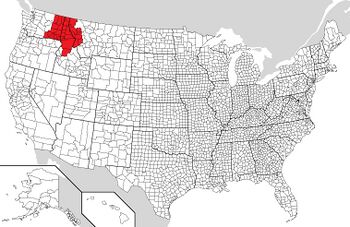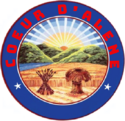Benewah: Difference between revisions
No edit summary |
No edit summary |
||
| Line 77: | Line 77: | ||
== Politics == | == Politics == | ||
The Executive of Coeur d’Alene holds office for a four-year term and can serve an unlimited number of terms. The Lieutenant- | The Executive of Coeur d’Alene holds office for a four-year term and can serve an unlimited number of terms. The Lieutenant-Executive, Secretary of State, Attorney General, Treasurer and National Superintendent of Public Instruction are also elected by the people to serve four year terms. The Executive of Coeur d’Alene appoints numerous state officers who serve as members of boards and commissions. | ||
===Legislature=== | ===Legislature=== | ||
Revision as of 03:35, 23 September 2022
This article is incomplete because it is pending further input from participants, or it is a work-in-progress by one author. Please comment on this article's talk page to share your input, comments and questions. Note: To contribute to this article, you may need to seek help from the author(s) of this page. |
Republic of Coeur d’Alene | |
|---|---|
|
Flag | |
| Motto: "Let it be Perpetual". | |
| Anthem: "Ours To Keep" | |
 | |
| Capital | Coeur d’Alene |
| Largest city | Spokane |
| Official languages | English |
| Government | Republic |
• Executive | Bill Williamson |
• Executive | Ken Rost |
| Legislature | Assembly |
| Population | |
• 2020 estimate | 1,493,000 |
| Currency | Coeur d’Alene Dollar (CAD) |
| Time zone | WST |
| Date format | dd-mm-yyyy |
| Driving side | right |
| Internet TLD | .CA |
Coeur d’Alene, officially the Republic of Coeur d’Alene, is a self-proclaimed breakaway state in the Inland Northwest of North America. The Republic of Coeur d’Alene is situated on both the Spokane River and Lake Coeur d'Alene, the nation's namesake. Spokane is the country's largest metropolitan area and the city of Coeur d’Alene serves as the capital. Bolstering a population of around 3,225,000, the Republic of Coeur d’Alene's economy is dominated by farming, lumber and wood products, mining and tourism.
History
In 1992, two years after the fall of the United States, Stanley Wilson, a former Postmaster in the city of Coeur d'Alene and who became Coeur d’Alene's national hero, launched a successful independence campaign against the Idaho state authorities, who had since lost effective control over the state as a whole minus several southern border counties. Wilson had also managed to gain the backing of the independent semi-city-states of Spokane and Missoula, which had both broke away from their former states in an armed struggle.
In 1993, the new government in Coeur d’Alene convened a constituent assembly of the three cities inside the Kootenai County Courthouse, where Wilson emerged as a champion of federalism, demanding political and economic autonomy for each area. The assembly left out southern Idaho as being part of the Republic of Coeur d'Alene, and made official the inclusion of Spokane and Missoula as being official constituents of the Republic of Coeur d’Alene. The name was picked because Coeur d'Alene was the central most city between the three, and the Coeur d'Alene National Forest was seen almost as a symbol of unity.
As a result, the remnant state government in southern Idaho broke with Coeur d’Alene and joined the Union of Utah-Nevada. The remnant state government of Montana had denounced the desicion to include counties that were rightfully a part of Montana.
In 1993, a force of Montana troops invaded lands claimed by the Republic of Coeur d’Alene. This led to the 500-day-long Montana-Coeur d’Alene War. Neither side gained the upper hand and in 1994 the Treaty of Three Forks gave birth to the de-jure Coeur d’Alene territories. October 22 is celebrated as Independence Day, a national holiday.
Geography
The Republic is bounded by the Cascade Mountains on the west and the Rocky Mountains (following the spine of the remote and rugged Cabinet Mountains) on the east, the Blue Mountains of Oregon and foothills of the Wallowa Mountains to the south, southeast, and encompasses the Columbia river basin (or Columbia Plateau). Between the three mountain ranges are large, sweeping areas of semi-arid steppe, part of which has been irrigated due to the Columbia Basin Project, resulting in expansive farmland in western part of Coeur d'Alene. The Palouse is another major agricultural region located in the gently rolling hills of central Coeur d'Alene. In northern Coeur d'Alene, the precipitation from the Pacific Ocean over the North Central Rockies forests, create the North American inland temperate rainforest. The Coeur d'Alene Mountains of this range is noted for its natural resource wealth, particularly the Silver Valley.
Spokane, the region's largest city, is located near where the arid, and largely unforested Columbia plateau meets the lush forests of the Selkirk Mountains. The urban area stretches east into central Coeur d'Alene along the I-90 corridor through the Spokane River valley across into the cities of Post Falls and Coeur d'Alene on the north bank of Lake Coeur d'Alene. The northern portion of the Republic are mountainous and forested, and the crest of the Bitterroot Range of the Rocky Mountains forms part of the eastern boundary, while the Columbia River forms a significant part of its southern boundary.
Politics
The Executive of Coeur d’Alene holds office for a four-year term and can serve an unlimited number of terms. The Lieutenant-Executive, Secretary of State, Attorney General, Treasurer and National Superintendent of Public Instruction are also elected by the people to serve four year terms. The Executive of Coeur d’Alene appoints numerous state officers who serve as members of boards and commissions.
Legislature
The legislature consists of a Senate of 31 members and an assembly of 91 members. Voters in each each of Coeur d’Alene's 31 senatorial districts elect one senator to a four-year term. One representative from each of the 91 districts is elected to the assembly. Representatives serve two-year terms. Regular sessions of the Legislature begin every year on January 1 and June 1. The major political parties are the National Unity Party, Centre Party, Civic Conservative Party, Progressive People's Party and the National Liberal Party.
Courts
The highest court in Coeur d’Alene is the Supreme Court. It has 3 justices, elected to 10-year terms. The justice who had been on the court for the longest time serves as the chief justice. Other Coeur d’Alene courts include an appellate court and circuit courts. The people elect judges of the courts to six-year terms. All Coeur d’Alene judges are elected on nonpartisan ballots.
Economy
The Coeur d'Alene economy is heavily based on agriculture, which in 2013 accounted for 24.5 per cent of gross domestic product, provides 85% of exports, and accounted for half of the employed workforce. Cattle is the second largest agriculture sector of the nation. Although dairy plays a significant role in the economy, Coeur d'Alene is most known for its potatoes. In 2010, Coeur d'Alene produced 74,512,000 CWT of potatoes and 51,374,000 bushels of wheat. Hay is grown primarily on the plains of the east. Sugar beets, like potatoes and wheat, are grown chiefly in the Snake River area. Beef cattle are perhaps the most valuable farm products. Most of the nation's cattle ranches lie on the central range oand the plains of southern Coeur d'Alene. Milk is the second most valuable livestock product. Dairy farms operate aling the Snake River Valley. Sheep graze in the mountains in summer and in the valleys and plains in winter. Agricultural cooperatives have become a lifeline for many farming communities, exporting cash crops to places like Kootenay, Nevada-Utah and the Republic of Reno-Tahoe.
Mining
Mining accounts for 3 percent of the gross state product. Silver, phosphate rock, and gold provide most of Coeur d'Alene's mining income. Shoshone County is one of the nations chief silver mining areas. Phosphate rock, which is used to make fertilizer, is mined the southeastern part of the nation. The nations largest gold mine is located near Stibnite in central Coeur d'Alene. Other important mineral products include clays, copper, crushed stone, garnet, molybdenum, sand and gravel, and vanadium.
Electric Power
Water is Coeur d'Alene's chief source of power. Power is generated by waterfalls and by water that tumbles over dams. Coeur d'Alene has 28 hydroelectric plants. The leading hydroelectric plants in the nation are at Albeni Falls, Anderson Ranch Dam, and Palisades Dam. The largest power company in Ceour d'Alene is Central Benewah Power Company, which supplies power to northern Ceour d'Alene, and Idaho Power Company, which owns a significant portion of dams in southern Coeur d'Alene.
Transportation
After the collapse of the United States and its logistics system, modern highways turned derelict and made reviving road transportation difficult for the successor states. Two major railroads, the Idaho Northern and Pacific Railroad and the Great Northwest Railroad supply freight service, and passenger trains serve five cities from Missoula to Spokane. Road trucking activity is present, but limited due to availability of parts and deterioration of roads.
Manufacturing
Food processing is Coeur d'Alene's leading manufacturing activity, and had about 10 potato-processing plants. Most food-processing plants are situated in southern Coeur d'Alene, which include beet-suggar refineries, canning and freezing companies, dairies, and plants that process meat, poultry and wheat. The production of chemicals, especially industrial and agricultural chemicals, are the most important. VYB Limited, which operates three ammunition and ammunition components plants in Lewiston, is a large supplier of ammunition to the military of Coeur d'Alene. The Lewis-Clark valley has an additional independent ammunition components manufacturer (Bryn & Gweith Armaments) and the Chipmunk Rifle Factory, now owned by a government subsidiary ArmaTek. Farm impliment machinery is produced by the newly created Allmand Tractor Company in Spokane, as an attempt to produce farm equipment parts domestically to keep the agricultural economy running.



